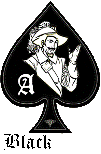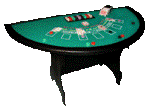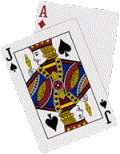 |
UNDERSTANDING BLACKJACK Before any cards are dealt, the player must wager. He does this by placing his bet in the designated space in front of his table position. The dealer then deals two cards to each of the players, and two to himself.The object of blackjack is to achieve a total that is greater than the dealer's without going over 21. If there are other players at the table, you are still only trying to beat the dealer. Blackjack is played with an international 52-card deck without jokers. The number of decks can be anything from two to eight decks in the shoe. Casinos normally use several decks mixed together to speed up the game and to make card counting more difficult. |
 |
 |
The Table: In casinos, blackjack is played on a specially designed table. There is a permanent
dealer employed by the casino. Blackjack tables feature enough seating for 6 blackjack players and each of them playing against the dealer.
Each player has a designated playing area in front of him where cards are placed and bets are made. The betting limits should be clearly
posted on a sign on the blackjack table. Normally, some of the most important rules are printed on the table - "Blackjack pays 3 to 2"
and "Dealer must draw on 16 and stand on all 17's". |
| The Chips: The standard denominations for casino chips: |
 |
Cards value: Face cards (Kings, Queens and Jacks) count as 10. The Ace has a special value in the game of blackjack because it can count either as 1 or 11, depending on what helps your hand the most. and all other cards are counted at their face value. |
 |
 |
The Deal and "blackjack"
The game begins after you've chosen a table, received your chips, and made your bet by placing it on the table in front of you in the
betting circle. Each player receives 2 cards (usually face up) on the table. The dealer receives 1 card face up and 1 card face down. The best
possible blackjack hand is an opening deal of an ace with any ten-point card. This is called a "blackjack", or a natural 21, and the player
holding this automatically wins unless the dealer also has a blackjack. If a player and the dealer each have a blackjack, the result is a
push for that player. If the dealer has a blackjack, all players not holding a blackjack lose. |
Player Options:
The rest of the game takes place after any blackjacks have been taken care of. The player closest to the left of the dealer is the first
player to act. His options are:
- Hit Taking another card.
- Stand Taking no more cards, your hand is set and finalized;
- Double Down If you're fairly sure that your hand will beat the dealer's, you can double your original bet. You're sometimes allowed to double down for any amount up to the original bet amount;
- Split Doubling your wager and having each initial card be the first card in two new separate hands;
- Surrender Forfeiting half of your wager and giving up your hand right then;
You have the option of taking as many hits as you want as long as you don't go over 21. When you go over 21, you tell the dealer you're going
to stand, and the game play moves along to the next player.
Dealer's Options:
The dealer acts last. After all the other players' action is resolved, the dealer flips over his hole card and reveals his total. The dealer
must play his hand according to the house rules. Usually the dealer must hit until he has a total of 17 or higher. If the dealer starts with
a total of 17, he stands.
The PAID
Winning and losing is determined after the dealer finishes playing his hand. The dealer pays out all the winning bets and collects all
the losing bets before the next hand begins.